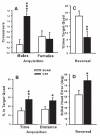Neurobehavioral phenotype of C57BL/6J mice prenatally and neonatally exposed to cigarette smoke
- PMID: 23314114
- PMCID: PMC3593942
- DOI: 10.1016/j.ntt.2013.01.001
Neurobehavioral phenotype of C57BL/6J mice prenatally and neonatally exposed to cigarette smoke
Abstract
Although maternal cigarette smoking during pregnancy is a well-documented risk factor for a variety of adverse pregnancy outcomes, how prenatal cigarette smoke exposure affects postnatal neurobehavioral/cognitive development remains poorly defined. In order to investigate the cause of an altered behavioral phenotype, mice developmentally exposed to a paradigm of 'active' maternal cigarette smoke is needed. Accordingly, cigarette smoke exposed (CSE) and air-exposed C57BL/6J mice were treated for 6h per day in paired inhalation chambers throughout gestation and lactation and were tested for neurobehavioral effects while controlling for litter effects. CSE mice exhibited less than normal anxiety in the elevated zero maze, transient hypoactivity during a 1h locomotor activity test, had longer latencies on the last day of cued Morris water maze testing, impaired hidden platform learning in the Morris water maze during acquisition, reversal, and shift trials, and impaired retention for platform location on probe trials after reversal but not after acquisition or shift. CSE mice also showed a sexually dimorphic response in central zone locomotion to a methamphetamine challenge (males under-responded and females over-responded), and showed reduced anxiety in the light-dark test by spending more time on the light side. No differences on tests of marble burying, acoustic startle response with prepulse inhibition, Cincinnati water maze, matching-to-sample Morris water maze, conditioned fear, forced swim, or MK-801-induced locomotor activation were found. Collectively, the data indicate that developmental cigarette smoke exposure induces subnormal anxiety in a novel environment, impairs spatial learning and reference memory while sparing other behaviors (route-based learning, fear conditioning, and forced swim immobility). The findings add support to mounting evidence that developmental cigarette smoke exposure has long-term adverse effects on brain function.
Copyright © 2013 Elsevier Inc. All rights reserved.
Figures






Similar articles
-
Prenatal immune challenge in rats: effects of polyinosinic-polycytidylic acid on spatial learning, prepulse inhibition, conditioned fear, and responses to MK-801 and amphetamine.Neurotoxicol Teratol. 2015 Jan-Feb;47:54-65. doi: 10.1016/j.ntt.2014.10.007. Epub 2014 Nov 8. Neurotoxicol Teratol. 2015. PMID: 25450663 Free PMC article.
-
Perinatal exposure to the selective serotonin reuptake inhibitor citalopram alters spatial learning and memory, anxiety, depression, and startle in Sprague-Dawley rats.Int J Dev Neurosci. 2016 Nov;54:39-52. doi: 10.1016/j.ijdevneu.2016.08.007. Epub 2016 Aug 31. Int J Dev Neurosci. 2016. PMID: 27591973
-
Developmental treatment with the dopamine D2/3 agonist quinpirole selectively impairs spatial learning in the Morris water maze.Neurotoxicol Teratol. 2009 Jan-Feb;31(1):1-10. doi: 10.1016/j.ntt.2008.09.003. Epub 2008 Sep 30. Neurotoxicol Teratol. 2009. PMID: 18930132
-
Prenatal immune challenge in rats: altered responses to dopaminergic and glutamatergic agents, prepulse inhibition of acoustic startle, and reduced route-based learning as a function of maternal body weight gain after prenatal exposure to poly IC.Synapse. 2012 Aug;66(8):725-37. doi: 10.1002/syn.21561. Epub 2012 May 15. Synapse. 2012. PMID: 22473973 Free PMC article.
-
Infant neurobehavioural consequences of prenatal cigarette exposure: A systematic review and meta-analysis.Acta Paediatr. 2020 Jun;109(6):1112-1124. doi: 10.1111/apa.15132. Epub 2020 Jan 24. Acta Paediatr. 2020. PMID: 31821600 Free PMC article.
Cited by
-
Developmental cigarette smoke exposure II: Kidney proteome profile alterations in 6 month old adult offspring.Reprod Toxicol. 2016 Oct;65:425-435. doi: 10.1016/j.reprotox.2016.05.008. Epub 2016 May 18. Reprod Toxicol. 2016. PMID: 27208485 Free PMC article.
-
Prenatal cigarette smoke exposure causes hyperactivity and aggressive behavior: role of altered catecholamines and BDNF.Exp Neurol. 2014 Apr;254:145-52. doi: 10.1016/j.expneurol.2014.01.016. Epub 2014 Jan 30. Exp Neurol. 2014. PMID: 24486851 Free PMC article.
-
Chronic psychosocial stress during pregnancy affects maternal behavior and neuroendocrine function and modulates hypothalamic CRH and nuclear steroid receptor expression.Transl Psychiatry. 2020 Jan 16;10(1):6. doi: 10.1038/s41398-020-0704-2. Transl Psychiatry. 2020. PMID: 32066677 Free PMC article.
-
Environmental Tobacco Smoke During the Early Postnatal Period of Mice Interferes With Brain 18 F-FDG Uptake From Infancy to Early Adulthood - A Longitudinal Study.Front Neurosci. 2020 Jan 29;14:5. doi: 10.3389/fnins.2020.00005. eCollection 2020. Front Neurosci. 2020. PMID: 32063826 Free PMC article.
-
Inhibition of Semaphorin 3A in Hippocampus Alleviates Postpartum Depression-Like Behaviors in Mice.Mol Neurobiol. 2025 Jun;62(6):7723-7737. doi: 10.1007/s12035-025-04752-5. Epub 2025 Feb 11. Mol Neurobiol. 2025. PMID: 39934560 Free PMC article.
References
-
- Abbott LC, Winzer-Serhan UH. Smoking during pregnancy: lessons learned from epidemiological studies and experimental studies using animal models. Crit Rev. Toxicol. 2012;42:279–303. - PubMed
-
- Abel EL. Smoking during pregnancy: a review of effects on growth and development of offspring. Hum. Biol. 1980;52:593–625. - PubMed
-
- Anderko L, Braun J, Auinger P. Contribution of tobacco smoke exposure to learning disabilities. J. Obstet. Gynecol. Neonatal Nurs. 2010;39:111–117. - PubMed
-
- Batstra L, Hadders-Algra M, Neeleman J. Effect of antenatal exposure to maternal smoking on behavioural problems and academic achievement in childhood: prospective evidence from a Dutch birth cohort. Early Hum. Dev. 2003;75:21–33. - PubMed
-
- Batty GD, Der G, Deary IJ. Effect of maternal smoking during pregnancy on offspring’s cognitive ability: empirical evidence for complete confounding in the US national longitudinal survey of youth. Pediatrics. 2006;118:943–950. - PubMed
Publication types
MeSH terms
Grants and funding
LinkOut - more resources
Full Text Sources
Other Literature Sources
Medical

